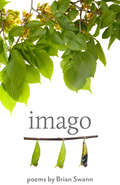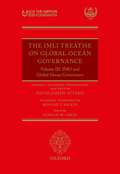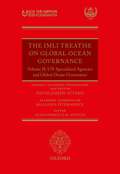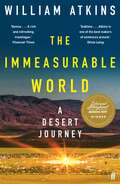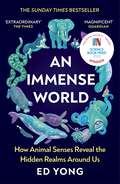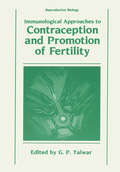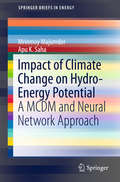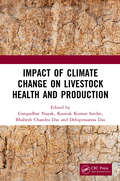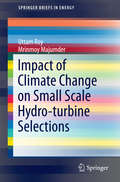- Table View
- List View
Imagining the Forest: Narratives of Michigan and the Upper Midwest
by John R. KnottForests have always been more than just their trees. The forests in Michigan (and similar forests in other Great Lakes states such as Wisconsin and Minnesota) played a role in the American cultural imagination from the beginnings of European settlement in the early nineteenth century to the present. Our relationships with those forests have been shaped by the cultural attitudes of the times, and people have invested in them both moral and spiritual meanings. Author John Knott draws upon such works as Simon Schama's Landscape and Memory and Robert Pogue Harrison's Forests: The Shadow of Civilization in exploring ways in which our relationships with forests have been shaped, using Michigan---its history of settlement, popular literature, and forest management controversies---as an exemplary case. Knott looks at such well-known figures as William Bradford, James Fenimore Cooper, John Muir, John Burroughs, and Teddy Roosevelt; Ojibwa conceptions of the forest and natural world (including how Longfellow mythologized them); early explorer accounts; and contemporary literature set in the Upper Peninsula, including Jim Harrison's True North and Philip Caputo's Indian Country. Two competing metaphors evolved over time, Knott shows: the forest as howling wilderness, impeding the progress of civilization and in need of subjugation, and the forest as temple or cathedral, worthy of reverence and protection. Imagining the Forestshows the origin and development of both.
Imagining the Plains of Latin America: An Ecocritical Study (Environmental Cultures)
by Axel Pérez DinizFrom the Pampas lowlands of Argentina, Uruguay and Brazil to the Altiplano plateau that stretches between Chile and Peru, the plains of Latin America have haunted the literature and culture of the continent. Bringing these landscapes into focus as a major subject of Latin American culture, this book outlines innovative new ecocritcial readings of canonical literary texts from the 19th century to the present. Tracing these natural landscapes across national borders the book develops a new transnational understanding of Hispanic culture in South America and expands the scope of the contemporary environmental humanities.Texts covered include works by: Ciro Alegría, Manoel de Barros, Ezequiel Martínez Estrada, Rómulo Gallegos, José Eustasio Rivera, João Guimarães Rosa, and Domingo Sarmiento.
Imagining the Plains of Latin America: An Ecocritical Study (Environmental Cultures)
by Axel Pérez DinizFrom the Pampas lowlands of Argentina, Uruguay and Brazil to the Altiplano plateau that stretches between Chile and Peru, the plains of Latin America have haunted the literature and culture of the continent. Bringing these landscapes into focus as a major subject of Latin American culture, this book outlines innovative new ecocritcial readings of canonical literary texts from the 19th century to the present. Tracing these natural landscapes across national borders the book develops a new transnational understanding of Hispanic culture in South America and expands the scope of the contemporary environmental humanities.Texts covered include works by: Ciro Alegría, Manoel de Barros, Ezequiel Martínez Estrada, Rómulo Gallegos, José Eustasio Rivera, João Guimarães Rosa, and Domingo Sarmiento.
Imago (Johns Hopkins: Poetry and Fiction)
by Brian SwannAn exuberant collection of poems celebrating art, nature, and humanity.This various and vital poetry collection, in rich language and sharp detail, spans the rural and urban, country and town, and foreign and domestic. Tracing the vagaries of the self, these poems record and transmute biography from an English youth to the trials and challenges of aging in America. Memorable for its exuberant voice and exacting eye, Brian Swann's Imago is awake to the natural world as well as the world within. From the half-page title poem to the multi-section "Elegiac," this volume is striking in its largeness, its tone evolving from self-indicting to ecstatic and self-transcendent. This collection, the author's fourteenth, is moving both as art and as testament.Imago unfolds much like a piece of music. It is a continuum by which Swann sees nature and art interwoven in the ways they emerge and change. In "Grief and Magritte," Swann muses upon "all of us snagged in a net whose skeins tangle in night sky / where one star dreams another." The title poem focuses on an insect "on its way through the changes, the patterns / of what led up to it, the catches and releases . . . saying now, and now" till "splitting down the back" such changes "release what was always there." Brian Swann's poems, moving in their candor, read as though they have always been there, too.
Imago (Johns Hopkins: Poetry and Fiction)
by Brian SwannAn exuberant collection of poems celebrating art, nature, and humanity.This various and vital poetry collection, in rich language and sharp detail, spans the rural and urban, country and town, and foreign and domestic. Tracing the vagaries of the self, these poems record and transmute biography from an English youth to the trials and challenges of aging in America. Memorable for its exuberant voice and exacting eye, Brian Swann's Imago is awake to the natural world as well as the world within. From the half-page title poem to the multi-section "Elegiac," this volume is striking in its largeness, its tone evolving from self-indicting to ecstatic and self-transcendent. This collection, the author's fourteenth, is moving both as art and as testament.Imago unfolds much like a piece of music. It is a continuum by which Swann sees nature and art interwoven in the ways they emerge and change. In "Grief and Magritte," Swann muses upon "all of us snagged in a net whose skeins tangle in night sky / where one star dreams another." The title poem focuses on an insect "on its way through the changes, the patterns / of what led up to it, the catches and releases . . . saying now, and now" till "splitting down the back" such changes "release what was always there." Brian Swann's poems, moving in their candor, read as though they have always been there, too.
The IMLI Treatise On Global Ocean Governance: Volume III: The IMO and Global Ocean Governance
by David Joseph AttardThe 1982 United Nations Convention on the Law of the Sea (UNCLOS) remains the cornerstone of global ocean governance. However, it lacks effective provisions or mechanisms to ensure that all ocean space and related problems are dealt with holistically. With seemingly no opportunity for revision due to the Conventions burdensome amendment provisions, complementary mechanisms dealing with such aspects of global ocean governance including maritime transport, fisheries, and marine environmental sustainability, have been developed under the aegis of the United Nations and other relevant international organizations. This approach is inherently fragmented and unable to achieve sustainable global ocean governance. In light of the Sustainable Development Goals (SDGs), particularly Goal 14, the IMLI Treatise proposes a new paradigm on the basis of integrated and cross-sectoral approach in order to realise a more effective and sustainable governance regime for the oceans. The volume examines how the IMO, with 171 Member States and 3 Associated Members, has and continues to promote the goals of safe, secure, sound, and efficient shipping on clean oceans. It studies the interface and interaction between UNCLOS and IMO instruments and how IMOs safety, security, and environmental protection conventions have contributed to global ocean governance, including the peaceful order of the polar regions.
The IMLI Treatise On Global Ocean Governance: Volume III: The IMO and Global Ocean Governance
by David Joseph AttardThe 1982 United Nations Convention on the Law of the Sea (UNCLOS) remains the cornerstone of global ocean governance. However, it lacks effective provisions or mechanisms to ensure that all ocean space and related problems are dealt with holistically. With seemingly no opportunity for revision due to the Conventions burdensome amendment provisions, complementary mechanisms dealing with such aspects of global ocean governance including maritime transport, fisheries, and marine environmental sustainability, have been developed under the aegis of the United Nations and other relevant international organizations. This approach is inherently fragmented and unable to achieve sustainable global ocean governance. In light of the Sustainable Development Goals (SDGs), particularly Goal 14, the IMLI Treatise proposes a new paradigm on the basis of integrated and cross-sectoral approach in order to realise a more effective and sustainable governance regime for the oceans. The volume examines how the IMO, with 171 Member States and 3 Associated Members, has and continues to promote the goals of safe, secure, sound, and efficient shipping on clean oceans. It studies the interface and interaction between UNCLOS and IMO instruments and how IMOs safety, security, and environmental protection conventions have contributed to global ocean governance, including the peaceful order of the polar regions.
The IMLI Treatise On Global Ocean Governance: Volume II: UN Specialized Agencies and Global Ocean Governance
by David Joseph AttardThe 1982 United Nations Convention on the Law of the Sea (UNCLOS) remains the cornerstone of global ocean governance. However, it lacks effective provisions or mechanisms to ensure that all ocean space and related problems are dealt with holistically. With seemingly no opportunity for revision due to the Conventions burdensome amendment provisions, complementary mechanisms dealing with such aspects of global ocean governance including maritime transport, fisheries, and marine environmental sustainability, have been developed under the aegis of the United Nations and other relevant international organizations. This approach is inherently fragmented and unable to achieve sustainable global ocean governance. In light of the Sustainable Development Goals (SDGs), particularly Goal 14, the IMLI Treatise proposes a new paradigm on the basis of integrated and cross-sectoral approach in order to realise a more effective and sustainable governance regime for the oceans. This volume focuses on the role of the UN Specialized Agencies towards the development of effective and sustainable ocean governance by looking at the more elaborate mechanisms they developed in order to achieve the desired objectives laid down in UNCLOS. From FAO to UNODC, the volume examines how they ensure sustainable development and how much coordination exists among them.
The IMLI Treatise On Global Ocean Governance: Volume II: UN Specialized Agencies and Global Ocean Governance
by David Joseph AttardThe 1982 United Nations Convention on the Law of the Sea (UNCLOS) remains the cornerstone of global ocean governance. However, it lacks effective provisions or mechanisms to ensure that all ocean space and related problems are dealt with holistically. With seemingly no opportunity for revision due to the Conventions burdensome amendment provisions, complementary mechanisms dealing with such aspects of global ocean governance including maritime transport, fisheries, and marine environmental sustainability, have been developed under the aegis of the United Nations and other relevant international organizations. This approach is inherently fragmented and unable to achieve sustainable global ocean governance. In light of the Sustainable Development Goals (SDGs), particularly Goal 14, the IMLI Treatise proposes a new paradigm on the basis of integrated and cross-sectoral approach in order to realise a more effective and sustainable governance regime for the oceans. This volume focuses on the role of the UN Specialized Agencies towards the development of effective and sustainable ocean governance by looking at the more elaborate mechanisms they developed in order to achieve the desired objectives laid down in UNCLOS. From FAO to UNODC, the volume examines how they ensure sustainable development and how much coordination exists among them.
The Immeasurable World: Journeys in Desert Places
by William AtkinsFor all the desert's dreamlike beauty, to travel here was not just to pitch yourself into oblivion: it was to grind away at yourself until nothing was left. It was to aspire to the condition of sand. One third of the earth's land surface is desert, much of it desolate and inhospitable. What is it about this harsh environment that has captivated humankind throughout history? From the prophets of the Bible to Marco Polo, Lawrence of Arabia to Gertrude Bell, travellers have often seen deserts as cursed places to be avoided, or crossed as quickly as possible. But for those whose call deserts home, the 'hideous blanks' described by explorers are rich in resources and significance.Travelling to five continents over three years, visiting deserts both iconic and little-known, William Atkins discovers a realm that is as much internal as physical. His journey takes him to the Arabian Peninsula's Empty Quarter and Australia's nuclear-test grounds; the dry Aral Sea of Kazakhstan and 'sand seas' of China's volatile north-west; the contested borderlands of Arizona and the riotous Burning Man festival in Nevada's Black Rock Desert; and the ancient monasteries of Egypt's Eastern Desert. Along the way, Atkins illuminates the people, history, topography, and symbolism of these remarkable but often troubled places.Reviving the illustrious British tradition of travel writing, The Immeasurable World is destined to become a classic of desert literature.
An Immense World: How Animal Senses Reveal the Hidden Realms Around Us (THE SUNDAY TIMES BESTSELLER)
by Ed Yong**Winner of the 2023 Royal Society Trivedi Science Book Prize**Discover the world as you've never seen it before - through the eyes of animals.'Immersive and mind-blowing' Peter Wohlleben, author of The Hidden Life of TreesThe Earth teems with sights and textures, sounds and vibrations, smells and tastes, electric and magnetic fields. But every animal is enclosed within its own unique sensory bubble, perceiving only a tiny sliver of this world.In An Immense World, Ed Yong coaxes us beyond the confines of our own senses, welcoming us into previously unfathomable dimensions - the world as it is truly perceived by other animals. Showing us that in order to understand our world we don't need to travel to other places; we need to see through other eyes.The perfect Christmas gift for nature lovers.A NEW YORK TIMES, GUARDIAN, ECONOMIST, SPECTATOR, TIMES LITERARY SUPPLEMENT and NEW STATESMAN BOOK OF THE YEAR**Winner of 2023 Carnegie Medal for Excellence in Nonfiction**'Suffused with magic' Siddhartha Mukherjee, author of The Song of the Cell'A book that prompts awe at the world around us' Sunday Times
Immunological Approaches to Contraception and Promotion of Fertility (Reproductive Biology)
by G. P. TalwarContraceptive research has entered the new age of vaccines. Realistic prospects exist for the development of an entirely new battery of vaccines for use in human and veterinary medicine. Among them may be anti-fertility vaccines, based on physiological mechanisms applicable to either the female or male. This volume is a comprehensive review - a status report - of the subjects including fundamental work on the search for useful epitopes and ranging to applied vaccinology. One vaccine to prevent pregnancy, for use by women, has already been studied extensively. G.P. Talwar, the volume's editor and his colleagues in New Oelhi, India, published in 1976 a landmark series of papers describing the immunological properties of a preparation consisting of the alum-precipitated beta-subunit of human chorionic gonadotropin (hCG) chemically linked to tetanus toxoid. The principle of enhancing antigenicity of a self-protein by linkage of the epitope to a carrier protein was employed and tested clinically. These trials, carried out under the auspices of the Indian Council for Medical Research, were the first application of the carrier protein concept for a vaccine for human use. The encouraging results stimulated a wave of research not only on the use of hCG-based vaccines, but on other antigens as well.
The Impact of Climate Change and Bioenergy on Nutrition
by Brian Thompson and Marc J. CohenClimate changes will affect food production in a number of ways. Crop yields, aquatic populations and forest productivity will decline, invasive insect and plant species will proliferate and desertification, soil salinization and water stress will increase. Each of these impacts will decrease food and nutrition security, primarily by reducing access to and availability of food, and also by increasing the risk of infectious disease.Although increased biofuel demand has the potential to increase incomes among producers, it can also negatively affect food and nutrition security. Land used for cultivating food crops may be diverted to biofuel production, creating food shortages and raising prices. Accelerations in unregulated or poorly regulated foreign direct investment, deforestation and unsustainable use of chemical fertilizers may also result. Biofuel production may reduce women’s control of resources, which may in turn reduce the quality of household diets. Each of these effects increases risk of poor food and nutrition security, either through decreased physical availability of food, decreased purchasing power, or increased risk of disease.The Impact of Climate Change and Bioenergy on Nutrition articulates the links between current environmental issues and food and nutrition security. It provides a unique collection of nutrition statistics, climate change projections, biofuel scenarios and food security information under one cover which will be of interest to policymakers, academia, agronomists, food and nutrition security planners, programme implementers, health workers and all those concerned about the current challenges of climate change, energy production, hunger and malnutrition.
Impact of Climate Change and Human Activity on the Eco-environment: An Analysis of the Xisha Islands (Springer Theses)
by Liqiang XuThis study describes the fundamentals of assessing the vulnerability of coral islands, as well as environmental management and resource exploitation. Using seabird subfossils, such as bones, guano, eggshells etc., which have been well preserved on the Xisha Islands in the South China Sea, the author identifies the influences of climate change and human activity on seabird populations and diets. Understanding the past is of great importance for predicting the future, and seabird subfossils provide valuable information, which can be used to study changes in seabird ecology, paleoceanography and palaeoclimate. Furthermore, this study proposes examining the biogeochemical cycling of some elements present in the geosphere, hydrosphere, biosphere and atmosphere.Dr. Liqiang Xu works at the Hefei University of Technology, China.
The Impact of Climate Change on European Lakes (Aquatic Ecology Series #4)
by Glen GeorgeIn this book, scientists from eleven countries summarize the results of an EU project (CLIME) that explored the effects of observed and projected changes in the climate on the dynamics of lakes in Northern, Western and Central Europe. Historical measurements from eighteen sites were used to compare the seasonal dynamics of the lakes and to assess their sensitivity to local, regional and global-scale changes in the weather. Simulations using a common set of water quality models, perturbed by six climate-change scenarios, were then used to assess the uncertainties associated with the projected changes in the climate. The book includes chapters on the phenology and modelling of lake ice, the supply and recycling of nitrogen and phosphorus, the flux of dissolved organic carbon and the growth and the seasonal succession of phytoplankton. There are also chapters on the coherent responses of lakes to changes in the circulation of the atmosphere, the development of a web-based Decision Support System and the implications of climate change for the Water Framework Directive.
Impact of Climate Change on Hydro-Energy Potential: A MCDM and Neural Network Approach (SpringerBriefs in Energy)
by Mrinmoy Majumder Apu K SahaThis Brief presents the impact of climatic abnormalities on hydropower potential of different regions of the World. In this regard, multi-criteria decision making and neural network are used to predict the impact of the change cognitively by an index. The results from the study show that the hydro-energy potential of the Asian region is mostly vulnerable with respect to other regions of the World. The model results also encourage further application of the index to analyse the impact of climate change on potential of hydro-energy.
Impact of Climate Change on Livestock Health and Production
by G D Nayak K K Sardar B C Das D P DasThis volume of 30 chapters contributed by reputed authors covers: Diversification of livestock and crops. Integration of livestock systems with forestry and crop production. Drought and heat wave tolerant varieties. Strategies for reduction of Green House Gases emission from ruminants. Application of GIS and remote sensing technologies. Breeds with inherent genetic capabilities to adapt to climate change. This book also takes into account the climate change adaptation, mitigation practices, and policy frameworks for promotion of sustainable livestock and poultry production. Print and electronic editions not for sale in South Asia (India, Sri Lanka, Nepal, Bangladesh, Pakistan, Afghanistan and Bhutan)
Impact of Climate Change on Livestock Health and Production
by Gangadhar Nayak Kautuk Kumar Sardar Bhabesh Chandra Das Debiprasanna DasThis volume of 30 chapters contributed by reputed authors covers: Diversification of livestock and crops. Integration of livestock systems with forestry and crop production. Drought and heat wave tolerant varieties. Strategies for reduction of Green House Gases emission from ruminants. Application of GIS and remote sensing technologies. Breeds with inherent genetic capabilities to adapt to climate change. This book also takes into account the climate change adaptation, mitigation practices, and policy frameworks for promotion of sustainable livestock and poultry production. Print and electronic editions not for sale in South Asia (India, Sri Lanka, Nepal, Bangladesh, Pakistan, Afghanistan and Bhutan)
Impact of Climate Change on Natural Resource Management
by Bipal K. Jana Mrinmoy MajumderAs climate change takes hold, there is an ever-growing need to develop and apply strategies that optimize the use of natural resources, both on land and in water. This book covers a huge range of strategies that can be applied to various sectors, from forests to flood control. Its aim, as with resource management itself, is to combine economics, policy and science to help rehabilitate and preserve our natural resources.Beginning with papers on carbon sequestration, including the practice of artificial desertification, the topics move on to cover the use of distributed modeling and neural networks in estimating water availability and distribution. Further chapters look at uncertainty analysis applied to the spatial variation of hydrologic resources, and finally the book covers attempts at estimating meteorological parameters in the context of hydrological variables such as evapo-transpiration from stream flow.Within the next decade, the effects of climate change will be severe, and felt by ordinary human beings. This book proposes a raft of measures that can mitigate, if not reverse, the impact of global warming on the resources we have all come to depend on.
The Impact of Climate Change on Our Life: The Questions of Sustainability
by Abdelnaser Omran Odile Schwarz-HerionThis book introduces the highly topical issue from many different angles, sensitizing readers to the various challenges to human life posed by climate change, identifying possible intentional and inadvertent anthropogenic factors and consequences, and seeking socially and environmentally viable solutions. The book begins by examining the impact of the climate change discussion on science, politics, economy and culture – from its historical origin in the first Club of Rome Report and its inclusion in the UN's SDGs to the Paris Agreement and beyond. Comprising 12 chapters, it analyses the factors which caused the catastrophic 2014 Kelantan flood in Malaysia, focusing on the Kuala Krai district and discusses mud architecture in Wadi Hadramout, Yemen and mitigating the expected effects of climate change on this unique architecture and cultural heritage. It also examines the economic costs of climate change on health and the increased burden on individual expenditures and national health systems. The role of climate change in the water-energy nexus and efforts to increase efficiency in energy and water end-use to increase Queensland’s agricultural sector’s resilience in Australia is addressed, as is water security and climate change issues in developing countries and the potential of partnership procurement strategies for managing sustainable urban water supply in Nigerian cities. It also includes a chapter offering a new approach to waste management, exploring to what extent waste can complicate our daily actions and influence environmental decay, and recommending that renewable materials be sorted and separated from other types of materials to avoid cross-contamination, to increase the value of the materials, and to ease the process of manufacturing. Subsequent chapters identify factors sustaining the municipal solid waste management and practices in Ajdabiya city in Libya, and look at accounting disclosure remedies by exploring areas in which sustainability reporting could expand beyond corporate environmental reporting to additional disclosures, curbing recklessness in pursuing merely economic goals. The book shows – from the perspective of agriculture – how human activities can increase the negative impacts of climate change on lifestyle in Malaysia, suggesting alternative lifestyles and encouraging international cooperative efforts. The last chapters evaluate the impacts of various environmental factors on the local tourism sector in Pakistan, and discuss strategies to tackle climate change, focusing on the opportunities and risks of climate engineering. Since these risks encompass inadvertent negative effects and targeted abuse for covert weather warfare and terrorism that violate the UN’s ENMOD convention, the author recommends viable alternatives to deal with climate change.
Impact of Climate Change on Small Scale Hydro-turbine Selections (SpringerBriefs in Energy)
by Uttam Roy Mrinmoy MajumderHydropower is found to be one of the most reliable and inexpensive options for renewable energy which was now widely been adopted by many countries to substitute fossil fuel sources. This Brief highlights the impact of climate change on hydropower plants, especially on the turbine design, as turbines are responsible for optimal conversion and regular energy production. The vulnerability of turbines is analyzed with the help of Artificial Neural Networks, followed by Multi Criteria Decision Making methods for development of intelligent indices to represent the level of vulnerability of turbines due to the change in climate.
Impact of Climate Change on Water Resources: With Modeling Techniques and Case Studies (Springer Climate)
by Komaragiri Srinivasa Raju Dasika Nagesh KumarThis book gives an overview of various aspects of climate change by integrating global climate models, downscaling approaches, and hydrological models. It also covers themes that help in understanding climate change in a holistic manner. The book includes worked-out examples, revision questions, exercise problems, and case studies, making it relevant for use as a textbook in graduate courses and professional development programs. The book will serve well researchers, students, as well as professionals working in the area of hydroclimatology.
Impact of COVID-19 Lockdown on Environmental Health: Exploring the Situation of the Lower Gangetic Delta
by Abhijit MitraThis book examines the impacts that the COVID-19 lockdown has had on environmental and ecological health, with a focus on coastal ecosystems in the Lower Gangetic Delta. The book begins with an overview of COVID-19's spread and impact before and after the lockdown in the focus region, then addresses the specific impacts that the lockdown period had and continues to have on air quality, marine and estuarine water quality, coastal biodiversity, and the livelihoods of the region's inhabitants, especially those who live below the poverty line. The decrease in human activity combined with the complete closure of various sectors, including air travel, oil and gas drilling, and construction, has had a pronounced effect on biodiversity and overall environmental health that is yet to be fully realized. The book sheds light on these changes and assesses how biodiversity, ambient air quality, and ecosystem functioning will progress as COVID-19 remains a threat and the lockdown persists. The study will be of interest to researchers, government officials and professionals dealing with disaster management, environmental science, biological science, and health.
The Impact of Displaced People’s Temporary Shelters on their Surrounding Environment (SpringerBriefs in Environment, Security, Development and Peace #16)
by Suwattana Thadaniti Supang ChantavanichThis book is one of four volumes on a major empirical migration study by leading Thai migration specialists from Chulalongkorn University (Bangkok) for the United Nations Development Programme (UNDP).this volume discusses the environmental impact of temporary shelters for displaced people along the Thai–Myanmar border. Of nine shelters, three were selected for detailed study: Ban Tham Hin (Ratchaburi province), Ban Mai Nai Soi (Mae Hong Son province), and Ban Mae La (Tak province). For each shelter, various research methods were used to assess the environmental conditions, analyse the ways of living and use of resources by displaced persons, and disclose their perceptions of the environmental conditions they face. The environmental impact of the shelters on the surrounding areas were also assessed by listening to officials and representatives. The book provides realistic policy recommendations for a durable solution for refugees at the borders. Practitioners and policymakers from governments, international organizations and NGOs will benefit from its findings. The volume is also helpful for anyone studying forced migration and its denouement in the age of globalization.
The Impact of Environmental Law: Stories of the World We Want (The IUCN Academy of Environmental Law series)
by Elizabeth A. Kirk Jessica Steinberg Albin Rose-Liza Eisma-OsorioThis cutting-edge book invites readers to rethink environmental law and its critical role in ensuring a sustainable future for all. Featuring international narratives, it demonstrates how environmental law can be a potent tool to secure multi-actor engagement, to improve ocean governance and to usher in effective policy reforms. Contributors illustrate narratives of successful historic and contemporary developments in environmental law, setting out innovative approaches to issues such as environmental enforcement and monitoring, effective forest protection, climate adaptation and disaster risk reduction. Drawing out key lessons and practices for effective reform, this insightful book highlights opportunities by which we can respond to the acute environmental challenges facing the planet. Bringing together perspectives from both established and up-and-coming scholars, this book will be of interest to academics and students of environmental law, as well as researchers of environmental management. Policy makers and practitioners will also find inspiration in fruitful stories of environmental law and policy reform.



